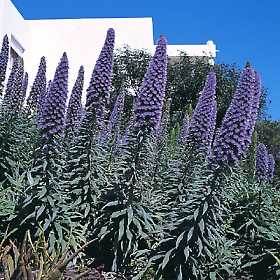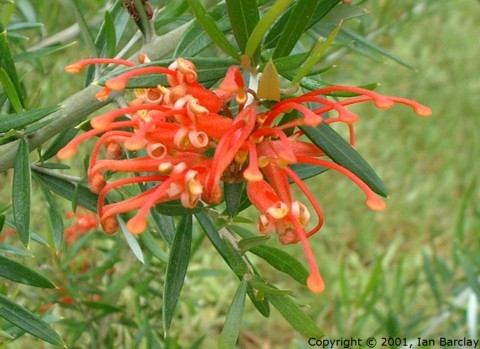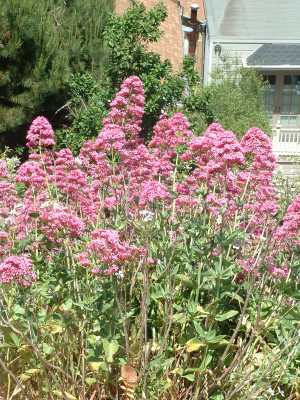This Knol is just a way for me to keep track of exactly what plants I have, but maybe it can help you learn a few things also.
I live in Aptos, which is just outside Santa Cruz, California. I live about a mile from the ocean, the temperature ranges here from about 30 to about 75. According to the Sunset "New Western Garden Book" I am in Zone 17 which also includes the entire cities of San Francisco and Oakland among others. One thing I have to warn you about... I am a lazy gardener. I do not want plants that need pruning, watering, or any other ing! They have to take care of themselves, more or less, and look beautiful or they get yanked out!
It's a strong, woody plant, the new shoots are tender. Cuttings don't usually take, and deliberately planted seeds don't seem to sprout for me, but it will drop seeds and seedlings will spring up around the base of the existing bush. These, once they are about five to eight inches tall can be carefully transplanted. It lasted through 35 degrees without covering it. And it never needs watering in my climate. Email me at wjhonson@aol.com and I will ship you ten seeds for five dollars. Or if you happen to live nearby, you can come pick up a baby up to 12 inches tall, in a pot for $12.
One thing to be careful about however, is that this plant is known to cause contact dermatitis, which if you've ever had poison ivy bumps you know what I mean. It seems to be more potent at some times than others. I've handled the plant needles many times and never had a problem, but the other day, I was lying on the ground reaching under the plant to pull out some non-poisonous ivy that was growing under it, and now I have bumps all over the back of my legs. Thank god for rubbing alcohol and hydro-cortisone.
I saw this plant for years at a favorite restaurant but nobody could tell me what it was. Finally I doggedly tracked down the caretaker and threatened her with a sharp stick. Of course even knowing the name none of my local nurseries carried this variety! They all carried the boring white flowering ones. So I found an online store and ordered a batch of seeds for like two bucks. Never had to order again, the things self-seed every year. I collected seeds from the first one, but never had to actually plant them. Hey if you want some seeds, I'll send you a batch of twenty for two bucks!
I'm not certain that I've correctly identified this grass which my neighbor gave me for free. It grows about 16" to 24" high. This next picture also looks a lot like it, but the photographer is only calling it "variegated grass" which isn't helpful at all ! This is NOT the small grass that you have to keep inside in a pot and which will die in temperatures of fifty degrees. I know this because my grass is outside all the time and we've had temperatures of 35 and it still comes back in the Spring all by itself. So maybe some reader will tell me if I have this correct as Moor grass.
I believe I must have picked up a few of these Valerian at a local "Native Revival" nursery or something of that sort. I suppose this must mean they are native to California. No maintenance, they self-seed every year. Grows to about 24" to 30" inches. The blooms at the top are very soft to the touch, look sort of like a cluster of broccoli rabe but in various colors.
This plant is thriving in a part of my yard, near a gigantic pine tree where almost nothing else will grow, except moss. So it's a welcome addition and always seems so cheerful, mixed in with the pine needle loom.
I have this plant in my yard which apparently loves the coast and grows in poor soil, but loves full direct sun. It's growing in part of my yard that has very hard soil and doing just fine. This is the fourth plant I've tried in this part of my yard, all the rest died. We are not talking about normally hard soil here folks, we're talking about half-hour with a pick axe to dig a one-foot deep hole hard... that's hard. This evergreen plant grows up to eight feet tall in a rounded shape and when it blooms has a spike of tiny clustered blue flowers surrounding a central conehead shape. The leaves are long, narrow, grey-green and slightly fuzzy. It's growing wild about 100 feet from the ocean, that's where I dug up a few babies and transplanted them to my yard. I finally today figured out what it's called, Echium. For years we've been calling it the "dinosaur plant", because it's enormous size and bizarre "ancient" look to us suggested that dinosaurs might have liked it as a mid-afternoon snack. The picture here gives you a good idea of the flower spike, but not really of the full plant as this is just showing the top. The one in my yard is a great rounded mass about five feet high and five to six feet wide.
I live in Aptos, which is just outside Santa Cruz, California. I live about a mile from the ocean, the temperature ranges here from about 30 to about 75. According to the Sunset "New Western Garden Book" I am in Zone 17 which also includes the entire cities of San Francisco and Oakland among others. One thing I have to warn you about... I am a lazy gardener. I do not want plants that need pruning, watering, or any other ing! They have to take care of themselves, more or less, and look beautiful or they get yanked out!
Grevillea [edit]
In about 2000 or so, I was wandering around with my partner at the Mendocino Coast Botanical Garden in Fort Bragg, California when we saw this large bush. It was probably about eight to ten feet tall and about ten feet wide with long, narrow, bright-red flowers on it. The thing that struck us both, was that there were several hummingbirds flying around it, as we watched. Luckily for us, the nursery had a small specimen, about five inches tall, for two dollars. Fort Bragg is over a hundred miles away from our house, but it has a similar ocean-side climate, so we decided to try it. The plant not only survived, it's now eight to ten feet tall and about eight feet wide. And we get several hummingbirds every year, who stick around for at least nine months. They love it, they visit it several times every day. They must be the Anna's hummingbirds which are year-round residents of coastal California. I think they like the color red, and they like flowers that are "trumpet" shaped or "tongue" shaped. The plant is called Grevillea 'Poorinda Queen'. I've included a picture of the flower in the upper-right. And the bush on the left here.It's a strong, woody plant, the new shoots are tender. Cuttings don't usually take, and deliberately planted seeds don't seem to sprout for me, but it will drop seeds and seedlings will spring up around the base of the existing bush. These, once they are about five to eight inches tall can be carefully transplanted. It lasted through 35 degrees without covering it. And it never needs watering in my climate. Email me at wjhonson@aol.com and I will ship you ten seeds for five dollars. Or if you happen to live nearby, you can come pick up a baby up to 12 inches tall, in a pot for $12.
One thing to be careful about however, is that this plant is known to cause contact dermatitis, which if you've ever had poison ivy bumps you know what I mean. It seems to be more potent at some times than others. I've handled the plant needles many times and never had a problem, but the other day, I was lying on the ground reaching under the plant to pull out some non-poisonous ivy that was growing under it, and now I have bumps all over the back of my legs. Thank god for rubbing alcohol and hydro-cortisone.
Buddleia [edit]
Buddleia is more commonly known as "Butterfly Bush" which is possibly a deceptive name because I've never particularly noticed butterflies around it. It's a tall narrow plant, growing perhaps to about eight feet, although the two I have are only about six feet tall right now. It has a long spike of flowers when in-bloom, but is a little temperamental and often won't flower at all some years, or only gets one spike, and sometimes looks straggly or "leggy". Here's a picture of the bloom. I'm not particularly fond of this plant, but they were free, and free is always the best price.Lychnis Coronaria[edit]
One of my favorite plants, Lychnis comes in a variety of colors, but they are all boring except the coronaria which are a deep blood red flower with gray-green leaves. The plant grows in a small mound close to the ground most of the year and then spikes start to come up in the Spring. The mound will be about four inches high and about eight inches wides. The Spikes shoot up to 24 inches high. Propagates by seeds, I've never tried cuttings, but it self-propagates in my area. Low-maintenance, the only thing I ever do is comb through it with my hands every month or so to cull the dead leaves. The leaves themselves feel very much like Lambs Ears if you're familiar with that soft and fuzzy kind of leaf.I saw this plant for years at a favorite restaurant but nobody could tell me what it was. Finally I doggedly tracked down the caretaker and threatened her with a sharp stick. Of course even knowing the name none of my local nurseries carried this variety! They all carried the boring white flowering ones. So I found an online store and ordered a batch of seeds for like two bucks. Never had to order again, the things self-seed every year. I collected seeds from the first one, but never had to actually plant them. Hey if you want some seeds, I'll send you a batch of twenty for two bucks!
Variegated Moor Grass [edit]
Molinia caerulea or "Variegated Moor Grass" is a very low maintenance plant, getting bushier every year and dying back in the Winter. It adds some nice bright-white to a garden and it always seems to remind me somehow of candy canes or those hard candies grandmas always have in a bowl.
I'm not certain that I've correctly identified this grass which my neighbor gave me for free. It grows about 16" to 24" high. This next picture also looks a lot like it, but the photographer is only calling it "variegated grass" which isn't helpful at all ! This is NOT the small grass that you have to keep inside in a pot and which will die in temperatures of fifty degrees. I know this because my grass is outside all the time and we've had temperatures of 35 and it still comes back in the Spring all by itself. So maybe some reader will tell me if I have this correct as Moor grass.
Alstroemeria [edit]
Also called "Peruvian Lily", I'd seen this cut flower for years in a favorite restaurant but they didn't know what it was called. And I couldn't find it at any of my local nurseries. Finally I found one at a flea market and the guy knew the name and sold me a mature plant for five bucks. It bloomed in the bucket for a year and then I decided to dig it out and separate the root tubers and plant portions in various parts of my yard and they all died.... Well I think one is growing but it hasn't bloomed yet, so I'm hoping it's this and not something else. I like the way this bloom has these "eyelashes" of various colors inside the flower. Very interesting. The flower blooms in a cluster at the top of a long stem, about 12" to 24" high.
Valerian [edit]
I believe I must have picked up a few of these Valerian at a local "Native Revival" nursery or something of that sort. I suppose this must mean they are native to California. No maintenance, they self-seed every year. Grows to about 24" to 30" inches. The blooms at the top are very soft to the touch, look sort of like a cluster of broccoli rabe but in various colors.
This plant is thriving in a part of my yard, near a gigantic pine tree where almost nothing else will grow, except moss. So it's a welcome addition and always seems so cheerful, mixed in with the pine needle loom.
Echium [edit]
 |
| Echium |
I have this plant in my yard which apparently loves the coast and grows in poor soil, but loves full direct sun. It's growing in part of my yard that has very hard soil and doing just fine. This is the fourth plant I've tried in this part of my yard, all the rest died. We are not talking about normally hard soil here folks, we're talking about half-hour with a pick axe to dig a one-foot deep hole hard... that's hard. This evergreen plant grows up to eight feet tall in a rounded shape and when it blooms has a spike of tiny clustered blue flowers surrounding a central conehead shape. The leaves are long, narrow, grey-green and slightly fuzzy. It's growing wild about 100 feet from the ocean, that's where I dug up a few babies and transplanted them to my yard. I finally today figured out what it's called, Echium. For years we've been calling it the "dinosaur plant", because it's enormous size and bizarre "ancient" look to us suggested that dinosaurs might have liked it as a mid-afternoon snack. The picture here gives you a good idea of the flower spike, but not really of the full plant as this is just showing the top. The one in my yard is a great rounded mass about five feet high and five to six feet wide.
There are evidently several varieties of Echium, but this picture looks the closest to what I have. The first two years I had it, it didn't bloom! That was disappointing, but this year I have about six spikes like this picture above.
You say you have a gigantic yard and a section of full sun area with bad soil? Here's another picture of what it could look like with Echium. Probably not much is going to grow under Echium by the way. The examples I've seen, the space under the plant is barren but might make a nice place for a child's secret fort.
You say you have a gigantic yard and a section of full sun area with bad soil? Here's another picture of what it could look like with Echium. Probably not much is going to grow under Echium by the way. The examples I've seen, the space under the plant is barren but might make a nice place for a child's secret fort.
What Is It? [edit]
I have an evergreen shrub I bought several years ago at a local plant store. When I bought it, it was about two to three feet tall, now it's about seven feet tall and about say three feet wide. I've had it planted in my yard, since I bought it about perhaps four to five years ago. I don't know what it is.
The main stalk and old branches are woody and the needles are dark green, but new growth stalks are very soft, not prickley at all and a light green. It blooms in the Winter through the Spring, the blooms fall off perhaps in April. The blooms grow mixed in with the needles and are very small, each about 1/4 inch, cup-shaped, pink with a black center which may just be the stamen or tiny seeds, I can't tell.
I've already looked half-way through my New Western Garden Book, and got as far as Leptospermum which we call "Tea Tree". It's pretty similar to that, but I'm not sure that's what it is. The book doesn't give any examples which have this kind of tiny tiny bloom. Do you know ?
I;'m looking right now through the CalFlora database to see if I can't identify it.









Great Photos
hi,
Anonymous - 19 May 2011Great photos. Why is it the flower names always hard to remember? It is like learning Alien's language. Check out http://www.beechwoodnurseries.com for your gardening needs.